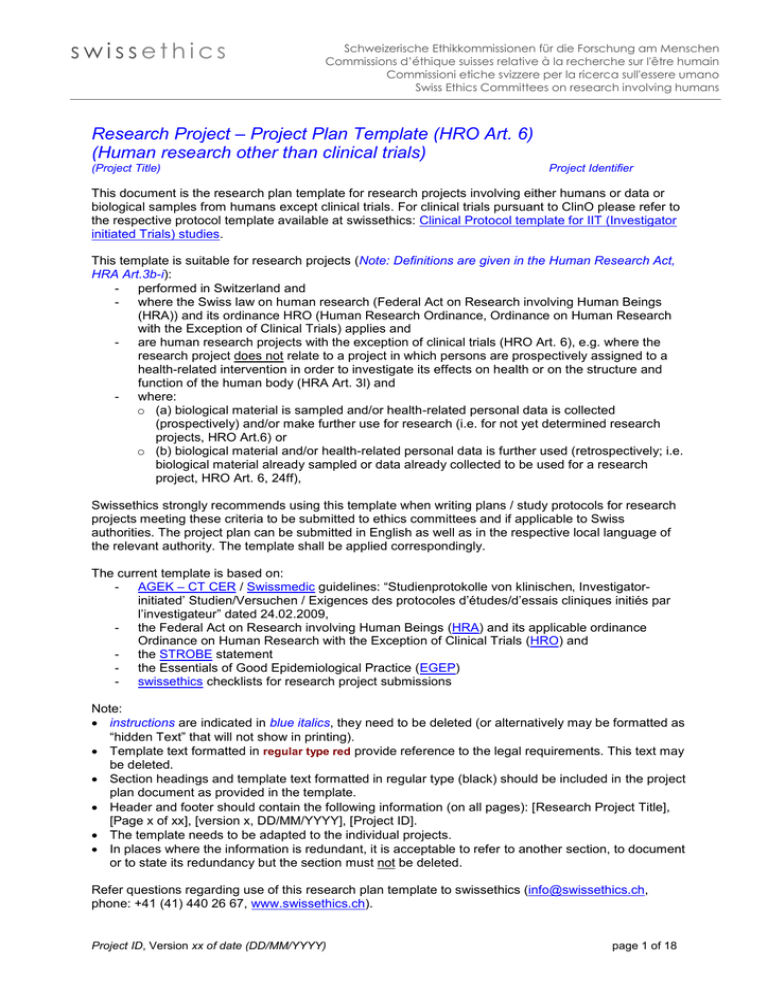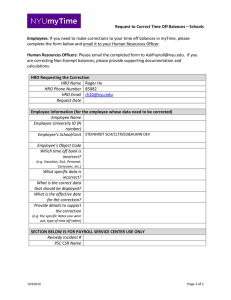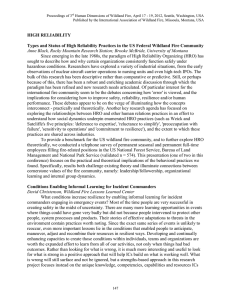project template for non interventional
advertisement

swissethics Schweizerische Ethikkommissionen für die Forschung am Menschen Commissions d’éthique suisses relative à la recherche sur l'être humain Commissioni etiche svizzere per la ricerca sull'essere umano Swiss Ethics Committees on research involving humans Research Project – Project Plan Template (HRO Art. 6) (Human research other than clinical trials) (Project Title) Project Identifier This document is the research plan template for research projects involving either humans or data or biological samples from humans except clinical trials. For clinical trials pursuant to ClinO please refer to the respective protocol template available at swissethics: Clinical Protocol template for IIT (Investigator initiated Trials) studies. This template is suitable for research projects (Note: Definitions are given in the Human Research Act, HRA Art.3b-i): - performed in Switzerland and - where the Swiss law on human research (Federal Act on Research involving Human Beings (HRA)) and its ordinance HRO (Human Research Ordinance, Ordinance on Human Research with the Exception of Clinical Trials) applies and - are human research projects with the exception of clinical trials (HRO Art. 6), e.g. where the research project does not relate to a project in which persons are prospectively assigned to a health-related intervention in order to investigate its effects on health or on the structure and function of the human body (HRA Art. 3l) and - where: o (a) biological material is sampled and/or health-related personal data is collected (prospectively) and/or make further use for research (i.e. for not yet determined research projects, HRO Art.6) or o (b) biological material and/or health-related personal data is further used (retrospectively; i.e. biological material already sampled or data already collected to be used for a research project, HRO Art. 6, 24ff), Swissethics strongly recommends using this template when writing plans / study protocols for research projects meeting these criteria to be submitted to ethics committees and if applicable to Swiss authorities. The project plan can be submitted in English as well as in the respective local language of the relevant authority. The template shall be applied correspondingly. The current template is based on: - AGEK – CT CER / Swissmedic guidelines: “Studienprotokolle von klinischen‚ Investigatorinitiated’ Studien/Versuchen / Exigences des protocoles d’études/d’essais cliniques initiés par l’investigateur” dated 24.02.2009, - the Federal Act on Research involving Human Beings (HRA) and its applicable ordinance Ordinance on Human Research with the Exception of Clinical Trials (HRO) and - the STROBE statement - the Essentials of Good Epidemiological Practice (EGEP) - swissethics checklists for research project submissions Note: instructions are indicated in blue italics, they need to be deleted (or alternatively may be formatted as “hidden Text” that will not show in printing). Template text formatted in regular type red provide reference to the legal requirements. This text may be deleted. Section headings and template text formatted in regular type (black) should be included in the project plan document as provided in the template. Header and footer should contain the following information (on all pages): [Research Project Title], [Page x of xx], [version x, DD/MM/YYYY], [Project ID]. The template needs to be adapted to the individual projects. In places where the information is redundant, it is acceptable to refer to another section, to document or to state its redundancy but the section must not be deleted. Refer questions regarding use of this research plan template to swissethics (info@swissethics.ch, phone: +41 (41) 440 26 67, www.swissethics.ch). Project ID, Version xx of date (DD/MM/YYYY) page 1 of 18 swissethics Schweizerische Ethikkommissionen für die Forschung am Menschen Commissions d’éthique suisses relative à la recherche sur l'être humain Commissioni etiche svizzere per la ricerca sull'essere umano Swiss Ethics Committees on research involving humans This template was adapted from the template for clinical trial protocols that was developed by a task force initiated by the Federal Office of Public Health (FOPH) and swissethics (former AGEK) in 2013 and under the lead and coordination of the Swiss Clinical Trial Organisation (SCTO). Clinical research experts from different institutions reviewed the present template. The FOPH and swissethics (former AGEK) reviewed the template and recommend its use. Contributors to this template and reviewers (alphabethic): - CHUV/PMU Lausanne, Dr Reto Auer - CHUV/IUMSP Lausanne and Cochrane Switzerland, Dr Bernard Burnand - CHUV/IUMSP Lausanne and Cochrane Switzerland, Dr Erik von Elm - EOC Ticino, Dr Stephany Fulda - EOC Ticino, Dr Liliane Petrini - HUG/CRC Geneva, Dr Christophe Combescure - HUG and CCER (Ethics Committee) Geneva, Prof Dr Bernard Hirschel - Swiss Paraplegic Centre Nottwil, Dr Angela Frotzler - SAKK and Charité Universitätsmedizin Berlin, PD Dr Pirus Ghadjar - SCTO Basel, Annette Magnin - SCTO Basel, Dr Caecilia Schmid - USZ/CTC Zurich, Dr Eva Brombacher - USZ Zurich, Dr Cédric Poyet Project ID, Version xx of date (DD/MM/YYYY) page 2 of 18 <<Research project template for non interventional research projects with humans, data or biological samples from humans>> Research Plan The Research Project Plan can be submitted in English or in the respective local language of the relevant authority. INSERT TITLE OF THE PROJECT (HRO Annex 2/1.2; STROBE 1) Descriptive title identifying the project design (e.g. qualitative research, fundamental research; sampling, etc.), population (if relevant), project set-up (e.g. multicentre / single centre; national / international) and target disease(s)/conditions/question. SHORT TITLE and / or project acronym and / or translation (if relevant; title used in the informed consent form) Type of Research Project: State research type: a) research project in which biological material is sampled from humans and/or health-related personal data is collected or b) research project in which already existing biological material and/or health-related personal data is further used for research Risk Categorisation: Provide Risk category: A or B or none according to ordinance HRO Art.7 (A and B are applicable in case of projects in which material is sampled and/or data is collected). Not applicable for research projects using already sampled biological material or data from humans. Project Identifier: If additional identifier applies (e.g. institutional or Sponsor project number) Project Leader: Name of Project Leader (and Sponsor if applicable) responsible for the research project (Title, Name, Position, full contact details) Health condition / problem Health condition or problem to be studied Project Duration Planned project period Project Plan Version and Date: Version number and date of the document Add, if applicable, the amendment number, from (date), replaces version number from (date) ACCESS TO RESEARCH DOCUMENTS Add a statement here respecting that it is not in conflict with applicable transparency rules. Project ID, Version xx of date (DD/MM/YYYY) page 3 of 18 SIGNATURE PAGE(S) (swissethics 0, 1a) Note: Add more lines, functions and pages if relevant, e.g. for project statistician, if relevant or project plan contributors Project number Project Title Provide if applicable the project identification number (institutional or sponsor etc.) Full project title as written out on title page The project leader and the methodologist (name the respective methodologist, e.g. statistician, clinical epidemiologist; also name if applicable the local project leaders in multicentre studies) have approved the research plan version [x (dated DD.MM.YYYY)], and confirm hereby to conduct the project according to the plan, the current version of the World Medical Association Declaration of Helsinki (name if applicable the principles to adhere, e.g. Principles of Good Clinical Practice (GCP) or the Essentials of Good Epidemiological Practice; (EGEP)) and the local legally applicable requirements. Project Leader: Printed name of Project Leader (if Sponsor and PL is not the same person please add an additional signature line for the Sponsor of the project) Place/Date Signature Project Methodologist (name the appropriate methodologist): Printed name of Methodologist Place/Date Project ID, Version xx of date (DD/MM/YYYY) Signature page 4 of 18 TABLE OF CONTENTS SYNOPSIS (SUMMARY) ........................................................................................................................ 6 ABBREVIATIONS ................................................................................................................................... 7 SCHEDULE OF ASSESSMENTS (FLOW OF RESEARCH PROJECT) ............................................... 8 1. ADMINISTRATIVE STRUCTURE ................................................................................................... 9 2. ETHICAL AND REGULATORY ASPECTS .................................................................................. 10 2.1 Ethical Conduct of Study .............................................................................................................. 10 2.2 Risk categorisation ....................................................................................................................... 10 2.3 Ethics Committee (EC) and Competent Authorities (CA), FOPH ................................................ 10 2.4 Participant Information and Informed Consent ............................................................................ 10 2.5 Participant privacy and safety ...................................................................................................... 10 2.6 Early termination of project .......................................................................................................... 11 2.7 Amendments, Changes ................................................................................................................ 11 3. INTRODUCTION............................................................................................................................ 12 3.1 Background .................................................................................................................................. 12 3.2 Rationale for the research project ................................................................................................ 12 3.3 Risk-Benefit Assessment ............................................................................................................. 12 4. OBJECTIVES, ENPOINTS/OUTCOMES AND OTHER STUDY VARIABLES ............................ 12 4.1 Objectives..................................................................................................................................... 12 4.2 Primary and secondary endpoint/outcome(s) .............................................................................. 12 4.3 Other study variables ................................................................................................................... 12 5. PROJECT DESIGN ....................................................................................................................... 13 5.1 Type of research and general project design............................................................................... 13 5.2 Procedures ................................................................................................................................... 13 5.3 Recruitment and Screening.......................................................................................................... 13 5.4 Methods of minimising bias .......................................................................................................... 13 6. PROJECT POPULATION .............................................................................................................. 14 6.1 Inclusion criteria ........................................................................................................................... 14 6.2 Exclusion criteria .......................................................................................................................... 14 6.3 Criteria for withdrawal / discontinuation of participants ................................................................ 14 7. PROJECT ASSESSMENTS .......................................................................................................... 14 7.1 Project flow chart(s) / table of procedures and assessments ...................................................... 14 7.2 Assessments of primary endpoint/outcome ................................................................................. 14 7.3 Assessment of secondary endpoint/outcome(s) .......................................................................... 14 7.4 Assessment of other study variables ........................................................................................... 14 7.5 Assessment of safety and reporting ............................................................................................. 15 7.5.1 Definition of Serious Events (SEs) ...................................................................................... 15 7.5.2 Assessment and Documentation of SEs............................................................................. 15 7.5.3 Reporting of SEs, Safety and Protective Measures ............................................................ 15 8. STATISTICAL METHODOLOGY .................................................................................................. 15 8.1 Determination of Sample Size...................................................................................................... 15 8.2 Data processing ........................................................................................................................... 15 8.3 Planned analysis .......................................................................................................................... 15 8.3.1 Datasets to be analysed ..................................................................................................... 16 8.3.2 Handling of missing data ..................................................................................................... 16 8.3.3 Ancillary analysis ................................................................................................................. 16 8.3.4 Deviations from the original statistical plan ......................................................................... 16 9. DATA AND QUALITY MANAGEMENT ........................................................................................ 16 9.1 Data handling and record keeping / archiving.............................................................................. 16 9.2 Confidentiality, Data Protection .................................................................................................... 16 9.3 Coding .......................................................................................................................................... 16 9.4 Archiving and Destruction ............................................................................................................ 16 10. PUBLICATION AND DISSEMINATION POLICY.......................................................................... 16 10.1 Publication of results ................................................................................................................... 17 10.2 Data sharing ................................................................................................................................ 17 11. FUNDING AND SUPPORT ............................................................................................................ 17 12. INSURANCE .................................................................................................................................. 17 13. REFERENCES ............................................................................................................................... 17 14. APPENDICES ................................................................................................................................ 18 Project ID, Version xx of date (DD/MM/YYYY) page 5 of 18 SYNOPSIS (SUMMARY) (HRO Annex 2/1.1) Provide a structured synopsis (summary) in the national language of the research site (titles shall be translated accordingly) containing all the important information, preferably in tabular view: Name of Project Leader or if applicable Sponsor and full contact details Project Leader (or Sponsor) Project Title: Short Title / Project ID: Project Plan Version and Date: Risk categorisation: Type of Research: Project design: Background and Rationale: Objective(s): Endpoint(s): Inclusion / Exclusion criteria: Project assessments, procedures: Number of Participants: Project Duration, schedule: Project Centre(s): Statistical Considerations: Other methodological Considerations: Risk-Benefit statement: Full title of project. Short title of project or project ID, if applicable. The version number and the date of the current research project plan. Provide Risk category A or B or none according to ordinance HRO Art.7 Research project in which biological material is sampled and/or health-related personal data is collected or project in which biological material and/or healthrelated personal data is used for further research. Mention whether coded or uncoded data are used. Design attributes such as qualitative studies, observational, case-control studies, cohorts, cross-sectional studies, prevalence studies, etc. or use of routine health data Provide a short background and the rationale for the research project, this includes the health condition / problem studied. Brief statement of the objectives Brief statement of the primary and secondary endpoints / outcomes Brief description of the anticipated project population, the key inclusion and exclusion criteria and if applicable, the reasons for inclusion of vulnerable participants. Describe the research project assessments, measurement, procedures (methodology, if applicable sampling of biological material). Number of participants planned for the entire project (e.g. not only for one centre, rather for entire project, all centres combined). Give the total and the numbers for each comparison group and the explanation for this sample size, based on a power analysis if applicable. Estimated duration for the research project and planned start / end. Single-centre or multi-centre. If multi-centre, note the number of projected centres to be involved. If it is a multi-national research project, also list the participating countries. A very brief description of the main elements of the statistical methodology to be used in the project; must include sample size considerations. If applicable describe here other methodological considerations than statistical, e.g. epidemiological, qualitative methods. Short description of risk / benefit assessment. Overall ethical justification of project, potential benefit of project results. Project ID, Version xx of date (DD/MM/YYYY) page 6 of 18 ABBREVIATIONS Provide a list of abbreviations used in the project plan - to be completed DoH EC EGEP FOPH HRA HRO ID IIT SE STROBE Declaration of Helsinki Ethics Committee Essentials of Good Epidemiological Practice Federal Office for Public Health Federal Act on Research involving Human Beings (Human Research Act, HRA) Ordinance on Human Research with the Exception of Clinical Trials (Human Research Ordinance, HRO) Identification Investigator-initiated Trial Serious event Strengthening the reporting of observational studies in epidemiology Project ID, Version xx of date (DD/MM/YYYY) page 7 of 18 SCHEDULE OF ASSESSMENTS (FLOW OF RESEARCH PROJECT) (STROBE #5, 13c) Insert if applicable a flow chart (graphic) or tabular listing of schedule of events and assessments and procedures of the project (an example is provided below, amend and expand according to the specific project). Project Periods Screening Visits (if applicable) Visit Time (hour, day, week) e.g. Participant Information and Informed Consent e.g. Demographics e.g. Medical History e.g. In- /Exclusion Criteria e.g Questionnaire (assessment of …) 1 -xd x e.g. any tests to assess eligibility x x x x x e.g. any tests during study to assess… 2 0d 3 xd 4 x+/-1d 5 x+/-1d 6 x+/-1d 7 x+/-1d 8 x+/-1d 9 x+/-1d 10 x+/-1d x x x x x x x x x x Primary Variables assessment test or questionnaire or other method Secondary Variables assessment test or questionnaire or other method x x x x x x x x x x x x x x x x x x x x Sampling of biological material x x x x x x x x x x x x x x x x x x x Serious (Adverse) Events Project ID, Version xx of date (DD/MM/YYYY) Page 8 of 18 1. ADMINISTRATIVE STRUCTURE (HRO Art. 3, 4, Annex 2/1.8; swissethics 8a, 8b) Provide the complete contact details (name, title, address, and telephone number) of the qualified Project Leader (and if applicable of the Sponsor or if applicable the coordinating researcher, the local project leaders at the project sites in case of a multicentre project, Sponsor representative in CH if applicable) who is responsible for the conduct of the project. Provide if applicable the contact details of the qualified statistician, the name of the laboratory, the site of the storage of health-related personal data and biological material, if applicable name e.g. the project coordination, data management, or if relevant any other committee (e.g. data monitoring committees, etc.) involved in the project (reference may be made to a different document, e.g. separate agreement). Sponsor, Project Leader and Coordinating researcher (if identical) to be adapted Sponsor representative in Switzerland (if applicable), Project Leader (if different from Sponsor), Coordinating researcher in case of multicentre studies (if different from above) Name: xx Address: xx Email: xx Phone: xx Fax: xx or refer to respective form/document delete word in row above Project site(s) and responsible researcher: Institution: xx Name: xx Address: xx Email: xx Phone: xx Fax: xx Key Persons involved in research project: Name: xx Address: xx Email: xx Phone: xx Fax: xx Other personnel or refer to respective form/document (e.g. staff list to submit to the EC) e.g. Biostatistician: Name: xx Address: xx Email: xx Phone: xx Fax: xx e.g. Laboratory: Institution: xx Name: xx Address: xx Email: xx Phone: xx Fax: xx Other (expand or delete if applicable): Name: xx Address: xx Email: xx Phone: xx Fax: xx Project ID, Version xx of date (DD/MM/YYYY) Page 9 of 18 2. ETHICAL AND REGULATORY ASPECTS 2.1 Ethical Conduct of Study (HRA Art. 45-49; HRO, Art. 14, 17-23, Annex 2) Commencement of this research project is conditional of the documented decision of the EC (and if applicable the FOPH) concerning the conduct of the project. The research project shall only begin once approval from all required authorities has been received. Any additional requirements imposed by the authorities shall be implemented. Provide a statement of seeking the necessary approvals. e.g. “The research project will be carried out in accordance to the research plan and with principles enunciated in the current version of the Declaration of Helsinki (DoH), the Essentials of Good Epidemiological Practice issued by Public Health Schweiz (EGEP), the Swiss Law and Swiss regulatory authority’s requirements as applicable. The EC and regulatory authorities (FOPH if radiation sources are involved) will be informed about project start and termination. 2.2 Risk categorisation (HRO Art. 7, 33) Describe the risk categorisation of the research project (research involving persons category A or B) and the rationale for the category (for details see HRO Art. 7). Projects not involving persons (e.g. further use of biological material and health-related personal data) are research projects and are not categorised (HRO Art. 33). 2.3 Ethics Committee (EC) and Competent Authorities (CA), FOPH (HRO Art. 14-23, 34, 37, 41, 45) Before the project will be conducted, the project plan, the proposed participant information and consent form as well as other project-specific documents shall be submitted to a competent Ethics Committee (EC). In case the project includes investigations involving radioactive sources, the opinion from the FOPH is required. Mention the reporting duties and allowed time frames (all changes in research activity and all unanticipated problems involving risks to humans; including the case of planned or premature project end and the final report). Note: The regular end, premature end or interruption of the research project is reported to the EC within 90 days upon completion of the project (HRO Art. 22). If radiation sources were involved, a final report needs to be sent to the FOPH within a year. 2.4 Participant Information and Informed Consent (HRO Art. 8, Annex 2/1.3-1.5) Explain that participants will be informed about the research project (what, how, by whom) and that consent is sought from each participant (or if applicable for studies using samples / data that consent has been obtained earlier); mention of compensation if any are foreseen and that informed consent may be sought for general and further use of data and/or biological samples. Describe key aspects regarding the rationale to include particularly vulnerable participants (or refer to relevant section where they are described, e.g. Chapter 3.3 Risk-benefit assessment) and describe what procedures are taken, including how to obtain informed consent without delay (see also HRA Art. 21-24, 30, 31). In the absence of informed consent: Research projects with retrospective data or samples having no participant consent may only be executed if requirements for exemption as stated in the HRA Art. 34 have been met. The ethical committee needs to approve the rationale provided in the project plan before issuing an authorisation. 2.5 Participant privacy and safety (HRA Art. 1, Annex 2/1.7) The Project Leader affirms and upholds the principle of the participants’ right to dignity, privacy and health and that the project team shall comply with applicable privacy laws. Especially, anonymity of the participants shall be guaranteed when presenting the data at scientific meetings or publishing them in scientific journals. Individual participant medical information obtained as a result of this research project is considered confidential and disclosure to third parties is prohibited. Participant confidentiality will be further ensured by utilising identification code numbers to correspond to medical information in the computer files. Project ID, Version xx of date (DD/MM/YYYY) Page 10 of 18 For data verification purposes, authorised representatives of the Sponsor, a competent authority (e.g. FOPH), or an ethics committee may require direct access to parts of the medical records relevant to the project, including participants’ medical history. 2.6 Early termination of project (HRO Art. 22) Describe the criteria for the termination of the project or the stopping rules. Provide a statement that the Sponsor, Project Leader (and any competent authority) may terminate the project prematurely according to certain circumstances (name the reasons, e.g., insufficient participant recruitment, ethical concerns, financial issues, change of project leader or any other reason that would prevent the project execution according to the research plan). Note: The premature end or interruption of the research project is reported to the EC within 90 days upon completion of the project (HRO Art. 22). If radiation sources were involved, a final report needs to be sent to the FOPH within a year. 2.7 Amendments, Changes (HRO Art. 18, 22, Annex 2) Significant changes to the project plan must be approved by the EC (amendments, if applicable according HRO Art. 18). Provide plans for communicating important research plan modifications (e.g., changes to eligibility criteria, outcomes, analyses) to relevant parties (e.g., investigators, EC, competent authorities). The Sponsor or Project Leader shall submit to the EC any application documents specified in Annex 2, which are affected by the change. At the same time, the project leader shall provide information on the reasons for the change. Substantial amendments are only implemented after approval of the EC. Project ID, Version xx of date (DD/MM/YYYY) Page 11 of 18 3. INTRODUCTION (STROBE 2; HRO Annex 2/1.2) 3.1 Background Describe the research question, including any scientific data (and if relevant any pre-/clinical evidence) on which the research project is based (published / unpublished) and including disease background, e.g. distribution in population, current standard of care (if relevant). Any statements that rely on existing knowledge or published information shall be adequately referenced. 3.2 Rationale for the research project Provide a clear statement on the rationale and justification of the research project, potential new findings, and choice of investigation and the project population. If sampling of materials or collection of data, provide rationale for creating a biobank or new registry. 3.3 Risk-Benefit Assessment (HRA Art. 12; HRO Art. 15) Assess the risk for project participants against the potential benefit (risk-benefit statement). Risk also includes the risk of unauthorised data access and/or unwanted identification of project participants. Describe key aspects regarding the rationale to include particularly vulnerable participants (or refer to section where they are described, e.g. Chapter 2.4 Participant Information and Informed Consent). For studies without immediate benefit to the project participant, a rationale should be provided stating how the results of the project could benefit future participants or patients with the same condition/indication due to e.g. a better understanding of the disease, recovery after surgical procedures, etc. This also includes a description of how risks to project participants are minimised and if applicable how postproject care and protection is implemented. Note: health-related data protection issues may also be of importance. 4. OBJECTIVES, ENPOINTS/OUTCOMES AND OTHER STUDY VARIABLES 4.1 Objectives (STROBE 3) Describe primary and secondary project objective(s). The primary objective should be clearly marked as such. Include any prespecified hypotheses if applicable. 4.2 Primary and secondary endpoint/outcome(s) (STROBE #7) Describe the primary, secondary, and other endpoint/outcome(s), including the specific measurement variable (e.g., systolic blood pressure or description of surrogate marker for non-measurable variables), analysis metric (e.g., change from baseline, final value, time to event), time point for each endpoint/outcome etc. The primary endpoint/outcome is the main variable that is measured at a precise time-point or at end of the investigation/observation to answer the primary research question. It should be measurable and should give information towards the project objective(s)). Provide a short description of the secondary endpoint/outcome variables and the rationale for the choice of endpoint/outcomes. 4.3 Other study variables (STROBE #7) Describe if applicable other study variables than endpoints, e.g. potential confounders and potential effect modifiers, exposures, predictors Project ID, Version xx of date (DD/MM/YYYY) Page 12 of 18 5. PROJECT DESIGN (STROBE 4,5, 9; HRO Annex 2/1.2) 5.1 Type of research and general project design (STROBE 4) Provide a description of the type of the project (qualitative, observational, fundamental, sampling or collection of data without research question at present), the project setup (e.g. multicentre / single centre; national / international). Describe the design of the research project and the rationale for the choice of design. Provide a discussion of the known or potential problems and limitations of the design. 5.2 Procedures (STROBE 5; swissethics 3a) Provide a description of intended procedures (assessments, measurements, project visits, interviews, etc.) and stages, the expected duration of participants’ participation, description of the sequence and duration of all research project periods, refer to schedule of assessment. For research projects in which biological material is sampled and/or health-related personal data is collected prospectively: Describe the project duration for each patient, the sequence of all procedures (questionnaires, project visits, etc.), the permitted timeframe for each visit, the material sampled and stored, as well as methods and tests used for sample collection and analysis, Describe project-specific procedures (i.e. performed outside clinical routine) or routine procedures (performed also in clinical routine / daily practice). For research projects in which already collected biological material and/or health-related personal data is used, describe the process of data acquisition, including what kind of data is taken and from which source (patient files, other sources) and what methods / procedures have been used for linkage of data sources. For biological material, describe what samples are taken, from which source and how they are tested. For projects without participant consent the following information (if not written elsewhere) needs to be provided to the Ethical Committee: designation of the group of persons who are to be entitled to pass on the biological material / health-related personal data, to receive the biological material / health-related personal data, persons responsible for protection of the data disclosed, group of persons who have access rights for the biological material / health-related personal data. 5.3 Recruitment and Screening (swissethics 3b) Describe procedures for participant recruitment, e.g., “consecutive ongoing recruitment through project leader in daily clinical practice”, or “participant recruitment through referring physician”, or “participant are contacted by letter and telephone” or “participant recruitment through advertisement placed in xx”; provide all relevant details (e.g. such as dates or location). If applicable, describe screening process and list any screening procedures, such as laboratory or diagnostic tests necessary to meet in- / exclusion criteria, refer to schedule of assessment. 5.4 Methods of minimising bias (STROBE 9; swissethics 2) If applicable, describe any biases that might be encountered during the conduct of your project and measures taken to reduce them (e.g. recruitment, outcome measurement, data collection, steps to reduce loss to follow up). Project ID, Version xx of date (DD/MM/YYYY) Page 13 of 18 6. PROJECT POPULATION (STROBE 6; HRO Annex 2/1.2) Describe project population, total number of participants and justification with respect to choice of project population. 6.1 Inclusion criteria Describe in detail the inclusion criteria for the participants’ eligibility for the project (if applicable, eligibility criteria for centres and individuals who will perform the interventions (e.g., surgeons, psychotherapists)). Create a list of criteria and be as specific as possible. List all project inclusion criteria, for example: target condition / diagnosis, therapeutic method, surgical procedure(s), clinical history, age (e.g. age ≥ 18 years), ethnic / sociodemographic background, life style factors (e.g. exercise, smoking history). 6.2 Exclusion criteria Describe in detail the exclusion criteria for the participants’ eligibility for the project. Create a list of criteria and be as specific as possible, for example: pregnant or lactating women, specific medication(s) or treatment(s), other clinically significant concomitant diseases (e.g. renal failure, hepatic dysfunction, cardiovascular disease, etc.), life style factors and addictions such as drug or alcohol abuse, inability to follow procedures (e.g. due to psychological disorders or dementia), insufficient knowledge of project language, etc. (depending on research project question, additional or other criteria may apply). 6.3 Criteria for withdrawal / discontinuation of participants Describe reasons for which a participant needs to discontinue from the project, e.g. withdrawal of informed consent, non-compliance, disease progression, etc. and describe procedures to follow in these cases (e.g. final examinations, that all biological materials / health-related data is anonymised upon termination of data analysis, except when the person concerned expressly renounces this right or if anonymisation is not possible and patient was informed and gave consent at the beginning of the project (HRO Art.10). 7. PROJECT ASSESSMENTS (STROBE 7; HRO Annex 2/1.2) Describe procedures, measurements, collection, storage of samples taken, data storage, etc. 7.1 Project flow chart(s) / table of procedures and assessments Provide a detailed graph, e.g. a flow chart or table ("assessment schedule") describing what is measured and how, grouped by primary, secondary and/or other endpoints/outcomes. Include the allowed time frames for each visit. The flow chart should comprise all procedures during the complete course of the project, not only the assessed endpoints. It may be referred to section “SCHEDULE OF ASSESSMENTS” in case all these details are provided there. 7.2 Assessments of primary endpoint/outcome Describe for the primary endpoint/outcome (if applicable) what variables will be assessed/observed and how this will be done (e.g., questionnaires, laboratory tests), including any related processes (methods) to promote data quality (e.g., duplicate measurements, training of assessors). Provide a rationale or justification for the use of certain methods and not others etc. Define the time windows allowed. 7.3 Assessment of secondary endpoint/outcome(s) Describe the secondary endpoint/outcome parameter(s), e.g. safety, quality of life. Specify the evaluation, at which time point and how it is assessed or measured (methodology). 7.4 Assessment of other study variables Describe if applicable how other study variables than endpoints (e.g. potential confounders and potential effect modifiers, exposures, predictors; demographic or other baseline characteristics) are assessed or measured. Project ID, Version xx of date (DD/MM/YYYY) Page 14 of 18 7.5 Assessment of safety and reporting (HRO Art. 20. 21) Describe plans for documentation of safety, serious events and protective measures if applicable for the type of project. The headings may be deleted if not applicable. 7.5.1 Definition of Serious Events (SEs) (HRO Art. 21) A serious event is any unfavourable event for which a causal relationship to sampling of biological material or the collection of health related personal data cannot be ruled out, and which: requires hospitalisation or prolongation of an inpatients’ hospitalisation, results in persistent or significant disability or incapacity, or is life-threatening or results in death, If a serious event occurs the research project will be set on hold. 7.5.2 Assessment and Documentation of SEs (HRO Art. 20, 21) The assessment by the project leader with regard to the project-specific measure relation is done according to the following definitions: Unrelated: The occurrence of the event has no temporal relationship to the project-specific measures applied and can be explained by the underlying disease or other factors. Related: There is a plausible temporal relationship between the occurrence of the event and the projectspecific, applied measures and cannot be explained by the underlying disease or other factors. All SEs are to be documented in the participants´ file and on the SE report form. A sample form is appended to the Protocol and can be downloaded at www.swissethics.ch. 7.5.3 Reporting of SEs, Safety and Protective Measures (HRO Art. 20) The project leader shall report any occurring SE to the responsible EC within 7 days (and to the FOPH in case of involved radioactive sources). He/she shall also submit a report which evaluates the relationship between the event reported and the methods of collecting health related personal data or sampling of biological material within that project, furthermore proposals how to proceed with the project. The project leader shall notify the EC within 7 days of any immediate other safety and protective measures, which have to be taken during the conduct of the research project. In addition, the project leader shall explain the circumstances, which necessitated the safety and protective measures. 8. STATISTICAL METHODOLOGY 8.1 Determination of Sample Size (STROBE 10) Describe the statistical rationale for sample size in terms of the power of the test to detect a given difference or attain a given precision in the primary endpoint. If this is not possible, the planned sample size should still be justified. 8.2 Data processing Identify any statistical procedures used to modify raw data before analysis (e.g., mathematically transforming continuous measurements to make distributions closer to the normal distribution, creating ratios or other derived variables, and collapsing continuous data into categorical data or combining categories). 8.3 Planned analysis (STROBE 12a-d) Describe the purpose of the planned analysis and the planned statistical methods for the primary and secondary endpoints/outcomes and level of significance used (usually two-sided α = 0.05). Describe procedures for reporting any deviations from the original statistical plan (normally described and justified in the final project report. Include the statistical software package(s) to be used. Project ID, Version xx of date (DD/MM/YYYY) Page 15 of 18 8.3.1 Datasets to be analysed Describe the data sets, analysis populations and comparison groups to be used for analysis and methods for any additional analyses (e.g., subgroup and adjusted analyses). 8.3.2 Handling of missing data Describe how missing data and data of drop-outs will be handled in the analysis. Ensure that an adequate number of participants will be evaluated, e.g. by compensating for expected drop-outs or by replacement. 8.3.3 Ancillary analysis If applicable, describe methods used for any planned ancillary analyses, such as sensitivity analyses, imputation of missing values, or testing of assumptions underlying methods of analysis. 8.3.4 Deviations from the original statistical plan Describe how any deviation(s) from the planned analyses will be justified and reported. 9. DATA AND QUALITY MANAGEMENT (HRO Art. 5, 25-27, Annex 2/1.7) Describe measures taken for data collection, handling, management and quality control: e.g. that project personnel is trained on all important project related aspects, that internal audits are planned, quality visits, independent data review (especially for correct consent and correct data protection), etc. 9.1 Data handling and record keeping / archiving (HRO Art. 5, 26, 27, Annex 2/1.7) Describe how data are handled and that all study related documents are archived (essential documents and site documents). 9.2 Confidentiality, Data Protection (HRO Art. 5) Data generation, transmission, storage and analysis of health related personal data and the storage of biological samples within this project will follow strictly the current Swiss legal requirements for data protection and will be performed according to the Ordinance HRO Art. 5. Health related personal data captured during this project and biological samples from participants are strictly confidential and disclosure to third parties is prohibited; coding will safeguard participants' confidentiality. Data protection: project data shall be handled with uttermost discretion and only be accessible to authorised personnel. Include a statement that direct access to source documents will be permitted for purposes of monitoring, audits or inspections and should declare who will have access to project plan, dataset, statistical code, etc. during and after the research project (publication, dissemination). 9.3 Coding (HRO Art. 25-27) Describe the coding procedures of biological material and/or health-related personal data, the storage location of the coding key and who has access to the key. The code may only be broken if it is necessary to avert an immediate risk to the health of the person concerned or to guarantee the rights of the person (e.g. in revoking the consent) or a legal basis exists for breaking the code. 9.4 Archiving and Destruction Specify time-period and location of storage of data. If applicable, describe how biological materials will be destroyed after project termination and how this will be documented or if there is any further use planned, such as for a biobank, in which case describe planned use and duration. 10. PUBLICATION AND DISSEMINATION POLICY (HRO Art. 15j; STROBE 22; HRO Annex 2/1.10) Project ID, Version xx of date (DD/MM/YYYY) Page 16 of 18 10.1 Publication of results Describe plans to communicate project results to participants, healthcare professionals, the public and other relevant groups (e.g., via publication, reporting in results databases). 10.2 Data sharing Describe if and how the project data can be accessed by interested third parties e.g. for replication or further analysis. Give contact details if applicable. Provide information about sharing also in case with third parties with lower data protection standards than CH or EU. 11. FUNDING AND SUPPORT (HRO Art. 15j; STROBE 22; HRO Annex 2/1.10) Provide a brief statement of sources and types of financial, material, and other support for the project. If applicable, make reference to other places or contracts/documents where this information is captured. Declare any conflict of interest if applicable and the role of the funders in the research project; otherwise provide a statement of no conflict of interest (independence, intellectual, financial, proprietary etc.) 12. INSURANCE (HRO Annex 1; HRO Annex 2/1.6) Research projects of category B need to document the guarantee of liability (insurance certificate or equivalent guarantee). It can be referred here to another source where the document has been made available, e.g. in Appendix or separate document. 13. REFERENCES Provide a list of the references cited in the project plan. 1. Declaration of Helsinki, Version October 2013, (http://www.wma.net/en/30publications/10policies/b3/index.html) 2. Essentials of Good Epidemiological Practice (EGEP; http://www.publichealth.ch/logicio/client/publichealth/file/EGEP_en.pdf) 3. Humanforschungsgesetz, HFG Bundesgesetz über die Forschung am Menschen (Bundesgesetz über die Forschung am Menschen, HFG) vom 30. September 2011/ Loi fédérale relative à la recherche sur l’être humain (loi relative à la recherche sur l’être humain, LRH) du 30 septembre 2011. (http://www.bag.admin.ch/themen/medizin/00701/00702/07558/index.html?lang=de) 4. Verordnung über die Humanforschung mit Ausnahme der klinischen Versuche (Humanforschungsverordnung, HFV) / Ordonnance relative à la recherche sur l'être humain à l'exception des essais cliniques (Ordonnance relative à la recherche sur l'être humain, ORH) / Ordinance on Human Research with the Exception of Clinical Trials (Human Research Ordinance, HRO) (http://www.admin.ch/opc/en/classified-compilation/20121177/index.html) 5. von Elm E, Altman DG, Egger M, Pocock SJ, Gøtzsche PC, et al. (2007) The Strengthening the Reporting of Observational Studies in Epidemiology (STROBE) Statement: Guidelines for Reporting Observational Studies. PLoS Med 4(10): e296. doi:10.1371/journal.pmed.0040296 6. Vandenbroucke JP, von Elm E, Altman DG, Gøtzsche PC, Mulrow CD, et al. (2007) Strengthening the Reporting of Observational Studies in Epidemiology (STROBE): Explanation and Elaboration. PLoS Med 4(10): e297. doi:10.1371/journal.pmed.0040297 7. Project ID, Version xx of date (DD/MM/YYYY) Page 17 of 18 14. APPENDICES Add any appendices here if relevant. For documents that change very frequently consider mentioning as separately provided documents with a link included here. Project ID, Version xx of date (DD/MM/YYYY) Page 18 of 18





